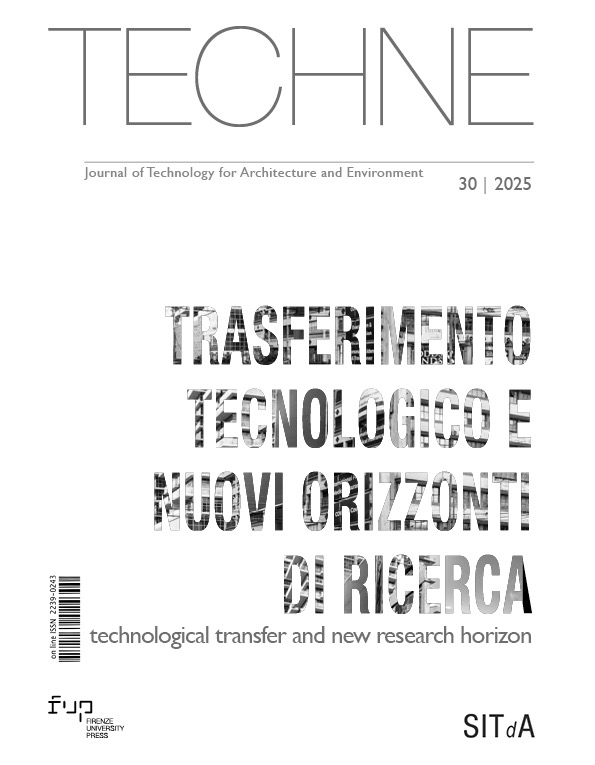RAISE e(co)-cities. Ecosystems, new technologies, and socioeconomic development in multi-urban networks
Published 2025-11-07
Keywords
- Living lab,
- inclusive technologies,
- generative artificial intelligence,
- prompt design,
- co-design
How to Cite
Copyright (c) 2025 Chiara Centanaro, Niccolò Casiddu, Manuel Gausa Navarro, Silvia Pericu, Nicola Valentino Canessa, Claudia Porfirione, Francesco Burlando

This work is licensed under a Creative Commons Attribution 4.0 International License.
Abstract
The RAISE project – Robotics and AI for Socio-economic Empowerment – funded by the MUR within the framework of the PNRR, strengthens innovation ecosystems by integrating research, industry, and local institutions. Leveraging robotic and AI technologies, it develops a citizen platform to enhance access to urban services and daily mobility. The methodological approach, based on integrating qualitative and quantitative analyses (user personas, journey maps, Urban Dashboard, and Multi Deprivation Index), is structured through co-design activities and the use of generative AI. This fosters active participation by citizens, public administration, and universities, providing replicable and scalable tools to create more inclusive urban environments oriented toward open and participatory governance.
Downloads
References
- Bruzzone, M. (2024), “Digital city & urban dashboard”, GUD, Vol. 10, pp. 112-119. Available at: https://www.stefanotermaninieditore.it/portale/gud-design-2/gud10-02_2024-interattive-interactive/ (Accessed on 02/05/2025).
- Canessa, N. V. (2024), “Genoa and Barcelona. Urban transformation and participation”, TECHNE – Journal of Technology for Architecture and Environment, Vol. 28, pp. 112–121. Available at https://doi.org/10.36253/techne-15822 (Accessed on 10/02/2025). DOI: https://doi.org/10.36253/techne-15822
- Crawford, S. and Goldsmith, S. (2014), The responsive city. Engaging Communities Through Data-Smart Governance, Jossey-Bass, San Francisco.
- Curedale, R. (2019), Empathy Maps: Step-by-step Guide, Design Community College Inc., Los Angeles.
- Dang, H., Mecke, L., Lehmann, F., Goller, S. and Buschek, D. (2022), “How to prompt? Opportunities and challenges of zero-and few-shot learning for human-AI interaction in creative applications of generative models”, CHI’22 Workshops, New Orleans, LA, May 10, 2022. Available at: https://arxiv.org/pdf/2209.01390 (Accessed on 03/02/2025).
- Dameri, R.P. and Bruzzone, M. (2024), “A Bidirectional Research Method to design a Smart City Evaluation System”, Proceedings of the 23rd European Conference on Research Methodology for Business and Management Studies, Vol. 23, n. 1, pp. 43-50. Available at https://doi.org/10.34190/ecrm.23.1.2405 (Accessed on 10/02/2025). DOI: https://doi.org/10.34190/ecrm.23.1.2405
- De Filippi, F. and Coscia, C. (2024), “Citizens’ engagement in the governance of urban common goods through digital tools”, TECHNE – Journal of Technology for Architecture and Environment, 28, pp. 260–269. Available at https://doi.org/10.36253/techne-15845 (Accessed on 10/02/2025). DOI: https://doi.org/10.36253/techne-15845
- García Robles, A., Hirvikoski, T., Schuurman, D. and Stokes, L. (Eds.) (2015), Introducing ENoLL and its Living Lab community, ENoLL, Brussels. Available at https://enoll.org/wp-content/uploads/2024/06/introducing-enoll-and-its-living-lab-community.pdf (Accessed on 02/05/2025).
- Gausa, M. (2019), “Mapping (in) the New Time. New Analytical-Synthetic Representations for the New n-City and its Multi-Territories”, diségno, Vol. 1, n. 5, pp. 143–156. Available at https://disegno.unioneitalianadisegno.it/index.php/disegno/article/view/142 (Accessed on 02/05/2025).
- LiCalab (2022), Establishing a Sustainable Living Lab, Thomas More – LiCalab, Living and Care lab, Brussels. Available at https://thomasmore.be/en/exp-zw/l/how-establish-sustainable-living-lab (Accessed on 02/05/2025).
- Magliocco, A. and Canepa, M. (2022), “Governance dashboards. Monitoring of key performance and aggregate indicators”, Agathón International Journal of Architecture, Art and Design, No .12, pp. 36-45. Available at doi.org/10.19229/2464-9309/1232022 (Accessed on 10/02/2025).
- O’Grady, V., O’Grady, J. (2017), A Designer’ s Research Manual, Succeed in design by knowing your clients and understanding what they really need, Rockport Publisher, Dover.
- Shou, Y., Zhang, X., Wang, C., Shen, A., Fan, H., Cai, R., Yin, Y., Zhou, J., Chai, C. and Sun, S. (2024), “Design Education in Human-AI Co-Creation: A Qualitative Analysis of Using Image Generative Models in Conceptual Design”, 2024 17th International Symposium on Computational Intelligence and Design (ISCID), Hangzhou, December 14-15, 2024, IEEE, pp. 23-27. Available at: http://doi.org/10.1109/ISCID63852.2024.00014 (Accessed on 30/06/2025). DOI: https://doi.org/10.1109/ISCID63852.2024.00014
- Souter, D. and van der Spuy, A. (2019), UNESCO’ S Internet Universality Indicators: A Framework for Assessing Internet Development, United Nations Educational, Scientific and Cultural Organization, Paris. Available at: https://unesdoc.unesco.org/ark:/48223/pf0000367617 (Accessed on 10/02/2025).
- Turillazzi, B., Boeri, A., Boulanger , S. O. M., Sabatini, F. and Trippa, C. (2024) “Public resources and communities: the role of the university in ecological transition”, TECHNE – Journal of Technology for Architecture and Environment, Vol. 28, pp. 152–158. Available at https://doi.org/10.36253/techne-15866 (Accessed on 10/02/2025). DOI: https://doi.org/10.36253/techne-15866
- UN High-Level Panel on Digital Cooperation (2019), The age of digital interdependence: report of the UN Sectretary-General’s High-leve Panel on Digital Cooperation. Available at: https://digitallibrary.un.org/record/3865925?v=pdf (Accessed on 10/02/2025).
- Verano Merino, M. and Sáenz, J. P. (2023), “The Art of Creating Code-Based Artworks”, Extended Abstracts of the 2023 CHI Conference on Human Factors in Computing Systems, article n.271. Available at: https://doi.org/10.1145/3544549.3585743 (Accessed on 29/06/2025). DOI: https://doi.org/10.1145/3544549.3585743






